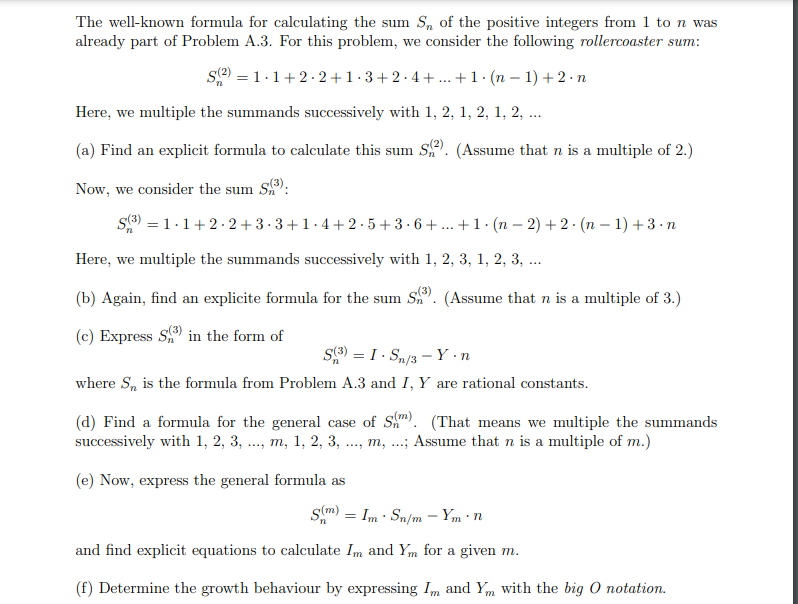The well-known formula for calculating the sum Sn of the positive integers from 1 to n was already part of Problem A.3. For this problem, we consider the following rollercoaster sum: S (2) n = 1 · 1 + 2 · 2 + 1 · 3 + 2 · 4 + ... + 1 · (n − 1) + 2 · n Here, we multiple the summands successively with 1, 2, 1, 2, 1, 2, ... (a) Find an explicit formula to calculate this sum S (2) n . (Assume that n is a multiple of 2.) Now, we consider the sum S (3) n : S (3) n = 1 · 1 + 2 · 2 + 3 · 3 + 1 · 4 + 2 · 5 + 3 · 6 + ... + 1 · (n − 2) + 2 · (n − 1) + 3 · n Here, we multiple the summands successively with 1, 2, 3, 1, 2, 3,
The well-known formula for calculating the sum Sn of the positive integers from 1 to n was
already part of Problem A.3. For this problem, we consider the following rollercoaster sum:
S
(2)
n = 1 · 1 + 2 · 2 + 1 · 3 + 2 · 4 + ... + 1 · (n − 1) + 2 · n
Here, we multiple the summands successively with 1, 2, 1, 2, 1, 2, ...
(a) Find an explicit formula to calculate this sum S
(2)
n . (Assume that n is a multiple of 2.)
Now, we consider the sum S
(3)
n :
S
(3)
n = 1 · 1 + 2 · 2 + 3 · 3 + 1 · 4 + 2 · 5 + 3 · 6 + ... + 1 · (n − 2) + 2 · (n − 1) + 3 · n
Here, we multiple the summands successively with 1, 2, 3, 1, 2, 3, ...
(b) Again, find an explicite formula for the sum S
(3)
n . (Assume that n is a multiple of 3.)
(c) Express S
(3)
n in the form of
S
(3)
n = I · Sn/3 − Y · n
where Sn is the formula from Problem A.3 and I, Y are rational constants.
(d) Find a formula for the general case of S
(m)
n . (That means we multiple the summands
successively with 1, 2, 3, ..., m, 1, 2, 3, ..., m, ...; Assume that n is a multiple of m.)
(e) Now, express the general formula as
S
(m)
n = Im · Sn/m − Ym · n
and find explicit equations to calculate Im and Ym for a given m.
(f) Determine the growth behaviour by expressing Im and Ym with the big O notation

Step by step
Solved in 2 steps






